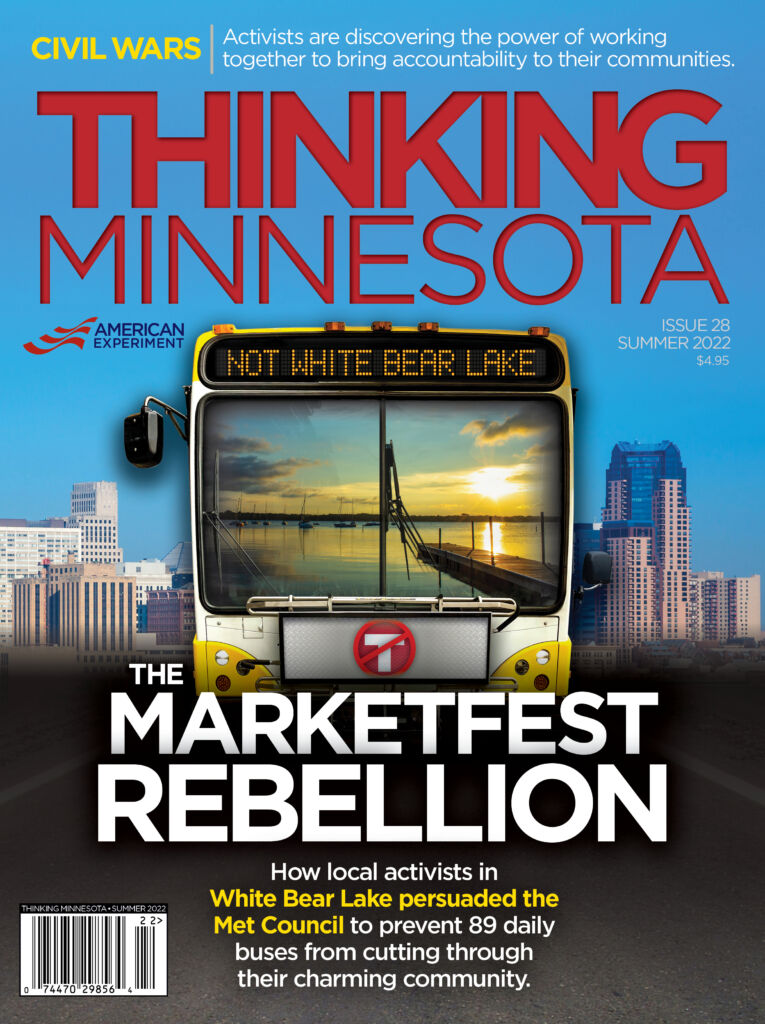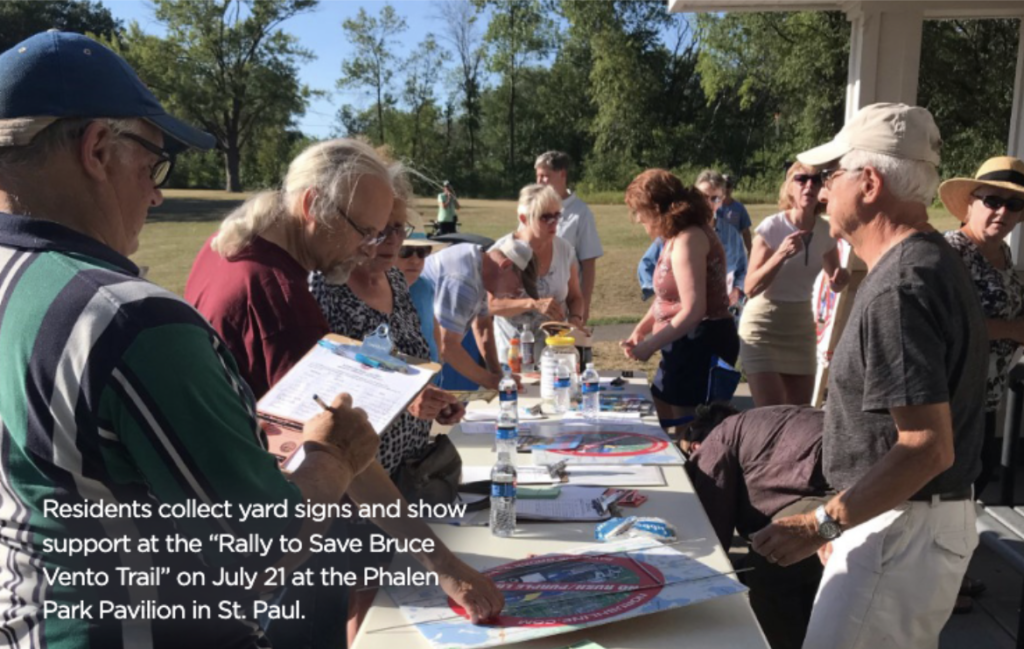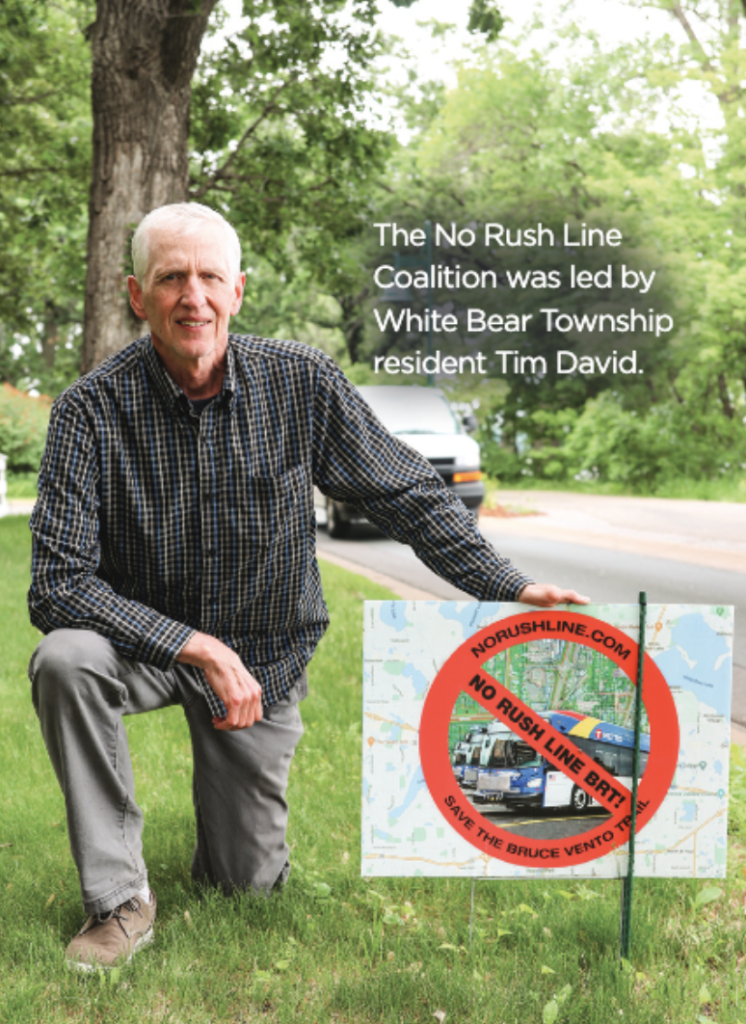Stopped dead in its tracks
Without White Bear Lake, ridership numbers can’t support federal funding for the Bus Rapid Transit Project.
There have been several major developments regarding the Purple Line Bus Rapid Transit project since it was featured in our summer 2022 Thinking Minnesota issue.

Tim David and his grassroots organization known as the No Rush Line Coalition did not rest on their laurels after successfully convincing the White Bear Lake City Council to pass a resolution against the Rush Line Bus Rapid Transit project. That resolution caused the Metropolitan Council to announce that several new routes were being considered, and none of them would encroach upon the city limits of White Bear Lake.
After the White Bear Lake victory, David and his crew of volunteers turned their attention to the City of Maplewood, focusing on how the Purple Line (renamed by the Met Council to better fit into their system) would drastically change the Bruce Vento Trail. The Bruce Vento Trail is a popular biking and walking trail that begins in downtown St. Paul and travels through Maplewood on abandoned railroad right-of-way. The corridor is currently lined with trees and provides a wooded path, making visitors forget they are in the middle of the city.
The plan for the Purple Line was to co-locate the bus route in the same corridor as the current trail. That would require bulldozing hundreds of trees on either side of the path to make room for two bus lanes and a rebuilt bituminous bike path.

The coalition organized the “Rally to Save Bruce Vento Trail” on July 21, 2022, at the Phalen Park Pavilion in St. Paul. According to David, about 150 people attended, completely filling the parking area, with some attendees walking several blocks to the event. After a brief presentation on the project, the floor was open to citizens in similar fashion to the town meeting held in White Bear Lake in October 2021.
“We wanted people to understand that the project was not a done deal just because Met Council and Ramsey County leaders supported it,” says David. “White Bear Lake stood up and said ‘no’ and Maplewood can do the same thing.”
The event took on the atmosphere of a pep rally as people clapped and cheered the idea that citizens, not bureaucrats, can decide how their communities can and should operate. Residents also spoke passionately about their opposition to the bus line and what it would do to the Bruce Vento Trail, which many described as an essential part of Maplewood. The coalition brought 50 “Stop the Rush Line” yard signs to be given out for a $5 donation. The signs sold out and a waiting list was formed with additional signs on backorder. Organizers were amazed at the attendance and passion against this project.
Stunning development

However, the No Rush Line Coalition may not have to host any more rallies, put up additional yard signs or convince any more city councils to oppose the project.
After the White Bear Lake setback, the Met Council regrouped and recommended three alternate routes. One travelled west into Vadnais Heights, ending at an already built park and ride facility. A second route travelled east to serve the students, staff, and faculty of Century College. And a third alternate simply ended at the Maplewood Mall Transit Center in Maplewood.
Unfortunately for supporters of the project, as it stands today, the Met Council cannot meet the federal requirements for ridership needed to receive funding. This major development was announced in an email on July 27, 2022, from Met Council staff: “…[W]e now know, due to changes in cost, corridor demographic and ridership projection guidance, the Purple Line project would not currently qualify for federal funding with any of the three potential northern endpoints in Maplewood, Vadnais Heights or at Century College.”
It appears that without the density of neighborhoods in White Bear Lake, the project can’t meet the ridership formula necessary to receive federal funding. The entire project is on life support. It’s a good reminder that this project has always been an application for federal grant funding from the Federal Transit Administration’s New Starts program and as such, Minnesota has been competing with other states and cities for funding.
It’s a pleasant surprise to learn the federal government has in place guidelines to make sure money isn’t wasted on projects that cost hundreds of millions of dollars and move very few people. That the Purple Line can’t even meet these basic benchmarks speaks volumes about the efficacy of the project.
The lesson? Grassroots activism works, and leaders sometimes listen.